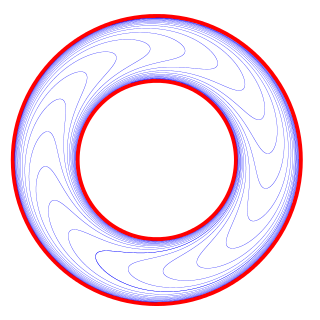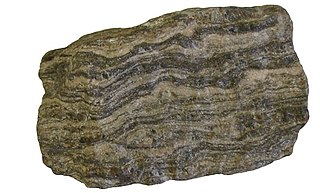This page is based on this
Wikipedia article Text is available under the
CC BY-SA 4.0 license; additional terms may apply.
Images, videos and audio are available under their respective licenses.
Structural geology is the study of the three-dimensional distribution of rock units with respect to their deformational histories. The primary goal of structural geology is to use measurements of present-day rock geometries to uncover information about the history of deformation (strain) in the rocks, and ultimately, to understand the stress field that resulted in the observed strain and geometries. This understanding of the dynamics of the stress field can be linked to important events in the geologic past; a common goal is to understand the structural evolution of a particular area with respect to regionally widespread patterns of rock deformation due to plate tectonics.

Trefoil is a graphic form composed of the outline of three overlapping rings used in architecture and Christian symbolism. The term is also applied to other symbols of three-fold shape.

The insects of the beetle family Chrysomelidae are commonly known as leaf beetles, and include over 37,000 species in more than 2,500 genera, making up one of the largest and most commonly encountered of all beetle families. Numerous subfamilies are recognized, but only some of them are listed below. The precise taxonomy and systematics are likely to change with ongoing research.

Phyllite is a type of foliated metamorphic rock created from slate that is further metamorphosed so that very fine grained white mica achieves a preferred orientation. It is primarily composed of quartz, sericite mica, and chlorite.
A leaf is an organ of a vascular plant.

In geology, a sill is a tabular sheet intrusion that has intruded between older layers of sedimentary rock, beds of volcanic lava or tuff, or along the direction of foliation in metamorphic rock. A sill is a concordant intrusive sheet, meaning that a sill does not cut across preexisting rock beds. Stacking of sills builds a sill complex and a large magma chamber at high magma flux. In contrast, a dike is a discordant intrusive sheet, which does cut across older rocks. Sills are fed by dikes, except in unusual locations where they form in nearly vertical beds attached directly to a magma source. The rocks must be brittle and fracture to create the planes along which the magma intrudes the parent rock bodies, whether this occurs along preexisting planes between sedimentary or volcanic beds or weakened planes related to foliation in metamorphic rock. These planes or weakened areas allow the intrusion of a thin sheet-like body of magma paralleling the existing bedding planes, concordant fracture zone, or foliations.
In mathematics, a taut foliation is a codimension 1 foliation of a 3-manifold with the property that there is a single transverse circle intersecting every leaf. By transverse circle, is meant a closed loop that is always transverse to the tangent field of the foliation. Equivalently, by a result of Dennis Sullivan, a codimension 1 foliation is taut if there exists a Riemannian metric that makes each leaf a minimal surface.
In mathematics, the Reeb foliation is a particular foliation of the 3-sphere, introduced by the French mathematician Georges Reeb (1920–1993).

Shear is the response of a rock to deformation usually by compressive stress and forms particular textures. Shear can be homogeneous or non-homogeneous, and may be pure shear or simple shear. Study of geological shear is related to the study of structural geology, rock microstructure or rock texture and fault mechanics.
In a geological context, crenulation or crenulation cleavage is a fabric formed in metamorphic rocks such as phyllite, schist and some gneiss by two or more stress directions causing the formation of the superimposed foliations.

Tectonites are metamorphic or tectonically deformed rocks whose fabric reflects the history of their deformation, or rocks with fabric that clearly displays coordinated geometric features that indicate continuous solid (ductile) flow during formation. Planar foliation results from a parallel orientation of platey mineral phases such as the phyllosilicates or graphite. Slender prismatic crystals such as amphibole produce a lineation in which these prisms or columnar crystals become aligned.
Tectonites are rocks with minerals that have been affected by natural forces of the earth, which allowed their orientations to change. This usually includes recrystallization of minerals, and the foliation formation. Tectonites are studied through structural analysis and allows for the determination of two things:

Crenigomphus hartmanni , the clubbed talontail, is a species of dragonfly in the family Gomphidae.

Cleavage, in structural geology and petrology, describes a type of planar rock feature that develops as a result of deformation and metamorphism. The degree of deformation and metamorphism along with rock type determines the kind of cleavage feature that develops. Generally these structures are formed in fine grained rocks composed of minerals affected by pressure solution.
In mathematics, Novikov's compact leaf theorem, named after Sergei Novikov, states that
In mathematics, Reeb sphere theorem, named after Georges Reeb, states that
In mathematics, Reeb stability theorem, named after Georges Reeb, asserts that if one leaf of a codimension-one foliation is closed and has finite fundamental group, then all the leaves are closed and have finite fundamental group.
In mathematics the Thurston boundary of Teichmüller space of a surface is obtained as the boundary of its closure in the projective space of functionals on simple closed curves on the surface. It can be interpreted as the space of projective measured foliations on the surface.
Paul Alexander Schweitzer, S. J., is an American mathematician, specializing in differential topology, geometric topology, and algebraic topology.









